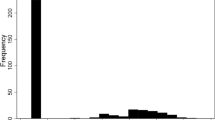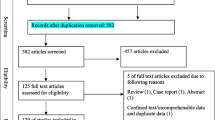Abstract
Campylobacteriosis has become common cause of diarrhea in humans and is associated with Guillain–Barré Syndrome, Reactive Arthritis and Irritable Bowel Syndrome is caused mainly by contaminated food and water intake in which the majority occurs from manipulation, preparation and consumption of poultry meat. The aim of this study was to estimate the prevalence of Campylobacter in chicken carcasses from slaughterhouses located in the states of Parana, Santa Catarina and Rio Grande do Sul in the South of Brazil. The samples were analyzed for Campylobacter enumeration using the ISO method 10272-2 and the species C. jejuni and C. coli, important for public health, were identified through Maldi-TOF mass spectrometry. From July 2017 to July 2018, 816 samples were analyzed, indicating the prevalence of 35.84%, with higher occurrence of C. jejuni (78.47%). No difference in prevalence was observed in relation to the size of the slaughterhouses. However, significant differences were noted among the three states in the southern region of the country, with the lowest prevalence being observed in Parana. The results reinforce the need to advance in the implementation of strategies to control this pathogen in the country, in order to safeguard consumer’s health and contribute for the maintenance of Brazil’s position in the international poultry meat market.




Similar content being viewed by others
References
Wagenaar JA, French NP, Havelaar AH (2013) Preventing Campylobacter at the source: why is it so difficult? Clin Infect Dis 57:1600–1606
WHO/FAO World Health Organization/Food and Agriculture Organization (2013) The global view of campylobacteriosis: report of an expert consultation. Utrecht
Pitkanen T, Hanninen ML (2017) Members of the family Campylobacteraceae: Campylobacter jejuni, Campylobacter coli. In: Rose JB, Jiménez-Cisneros B (eds) Global water pathogens project. Michigan State University, E. Lansing, MI, UNESCO
EFSA European Food Safety Authority and European Centre For Disease Prevention and Control (ECDC) (2018) The European union summary report on trends and sources of zoonoses, zoonotic agents and food-borne outbreaks in 2017. EFSA J 16:5077
Epps SVR, Harvey RB, Hume ME et al (2013) Review foodborne Campylobacter: infections, metabolism, pathogenesis and reservoirs. Int J Environ Res Public Health 10:6292–6304
Hoffmann S, Devleesschauwer B, Aspinall W et al (2017) Attribution of global foodborne disease to specific foods: findings from a World Health Organization structured expert elicitation. PLoS ONE 12:e0183641
USDA/FSIS United States Department of Agriculture, Food Safety and Inspection Service (2008) The nationwide microbiological baseline data collection program: young chicken survey. July 2007–2008
Canada (2016) Canadian Food Inspection Agency (CFIA). National microbiological baseline stud y in broiler chicken. December 2012–2013
EFSA European Food Safety Authority (2010) Analysis of the baseline survey on the prevalence of Campylobacter in broiler batches and of Campylobacter and Salmonella on broiler carcasses in the EU, 2008, Part A: Campylobacter and Salmonella prevalence estimates. EFSA J 8:1503
European Union (EU) (2017) Commission regulation (EC) 2017/1495 of 23 August 2017 amending regulation (EU) 2073/2005 as regards Campylobacter in broiler carcasses. Official Journal of European Union
Brasil (2017) Ministério da Agricultura, Pecuária e Abastecimento. Norma Interna DIPOA/SDA n 2, de 12 de junho de 2017. Estabelece o programa exploratório para pesquisa e estimativa de Campylobacter spp em carcaças de frangos. Boletim de Pessoal, Brasília
ISO International Standards Organization (2017) 17025 General requirements for the competence of testing and calibration laboratories. International Standard ISO, Geneva
ISO International Standards Organization (2017) 10272-2 Microbiology of the food chain—horizontal method for the detection and enumeration of Campylobacter spp. Part 2: Colony count technique. International Standard—ISO. Geneva
Rodrigues CS, Armendaris PM (2018) Avaliação de amostras de carcaças de frango para presença e prevalência de Campylobacter nos SIFs do Brasil. Fundação APINCO de Ciência e Tecnologia Avícolas (FACTA). http://www.facta.org.br/salmonella2018/anais/view/home/. Accessed Apr 17 2019
StataCorp (2015) Stata statistical software: release 14. College Station, Texas
Rodrigues WOP, Garcia RG, Naas IA et al (2014) Evolução da avicultura de corte no Brasil. Enciclopédia Biosfera, Centro Científico Conhecer 10:1666–1684
Sheppard SK, Maiden MCJ (2015) The evolution of Campylobacter jejuni and Campylobacter coli. Cold Spring Harb Perspect Biol 7:a018119
Seliwiorstow T, Zutter L, Houf K et al (2016) Comparative performance of isolation methods using Preston broth, Bolton broth and their modifications for the detection of Campylobacter spp from naturally contaminated fresh and frozen raw poultry meat. Int J Food Microbiol 234:60–64
Melo RT (2012) Fatores de patogenicidade e potencial risco à saúde em Campylobacter spp. isoladas em carcaças de frango. Dissertation, Federal University of Uberaba
Lobo A (2018) Desempenho logístico: Brasil sofre com falta de infraestrutura. ILOS Especialistas em Logística e Supply Chain. http://www.ilos.com.br/web/lpi-o-brasil-continua-sofrendo-com-a-infraestrutura/. Accessed May 14 2019
EFSA European Food Safety Authority (2010) Analysis of the baseline survey on the prevalence of Campylobacter in broiler batches and of Campylobacter and Salmonella on broiler carcasses in the EU, 2008, Part B: Analysis of factors associated with Campylobacter colonization of broiler batches and with Campylobacter contamination of broiler carcasses; and investigation of the culture method diagnostic characteristics used to analyse broiler carcass samples. EFSA J 8:1522
Lee J, Castle M, Duncan G et al (2015) Example of a microbiological criterion (MC) for verifying the performance of a food safety control system: Campylobacter performance target at end of processing of broiler chickens. Food Control 58:23–28
Sampers I, Habib I, Zutter L et al (2010) Survival of Campylobacter spp in poultry meat preparations subject to freezing, refrigeration, minor salt concentration and heat treatment. Int J Food Microbiol 137:147–153
Rosenquist H, Sommer HM, Nielsen NL et al (2006) The effect of slaughter operations on the contamination of chicken carcasses with thermotolerant Campylobacter. Int J Food Microbiol 108:226–232
Sandberg M, Hofshagen M, Ostensvik O et al (2005) Survival of Campylobacter on frozen broiler carcasses as a function of time. J Food Prot 68:1600–1605
WHO/FAO World Health Organization/Food and Agriculture Organization (2009) Risk assessment of Campylobacter spp. in broiler chickens: interpretative summary. Microbiological Risk Assessment Series No 11. Geneva
Han Z, Willer T, Li L et al (2017) Influence of the gut microbiota composition on Campylobacter jejuni colonization in chickens. Infect Immun 85:e00380-e417
Melo RT, Grazziotin AL, Júnior-Valadares EC et al (2019) Evolution of Campylobacter jejuni of poultry origin in Brazil. Food Microbiol 82:489–496
Berghaus RD, Thayer SG, Law BF et al (2013) Enumeration of Salmonella and Campylobacter spp in environmental farm samples and processing plant carcass rinses from commercial broiler chicken flocks. Appl Environ Microbiol 79:4106–4114
Nauta M, Johannessen G, Adame LL et al (2016) The effect of reducing numbers of Campylobacter in broiler intestines on human health risk. Microb Risk Anal 1–2:68–77
CAC Codex Alimentarius Commission (2011) Guidelines for the control of Campylobacter and Salmonella in chicken meat. CAC/GL 78/2011
Seliwiorstow T, Baré J, Berkvens D et al (2016) Identification of risk factors for Campylobacter contamination levels on broiler carcasses during the slaughter process. Int J Food Microbiol 226:26–32
Lehner Y, Reich F, Klein G (2014) Influence of process parameter on Campylobacter spp. counts on poultry meat in a slaughterhouse environment. Curr Microbiol 69:240–244. https://doi.org/10.1007/s00284-014-0575-y
Kouglenou SD, Agbankpe AJ, Dougnon V, Djeuda AD, Deguenon E, Hidjo M, Baba-Moussa L, Bankole H (2020) Prevalence and susceptibility to antibiotics from Campylobacter jejuni and Campylobacter coli isolated from chicken meat in southern Benin. West Africa BMC Res Notes 13:305. https://doi.org/10.1186/s13104-020-05150-x
Ramonaitė S, Novoslavskij A, Zakarienė G, Aksomaitienė J, Malakauskas M (2015) High prevalence and genetic diversity of Campylobacter jejuni in wild crows and pigeons. Curr Microbiol 71:559–565. https://doi.org/10.1007/s00284-015-0881-z
Acknowledgments
To Coordination for the Improvement of Higher Education Personnel (CAPES) and to the Ministry of Agriculture, Livestock and Food Supply (MAPA) (Process No. 21000.055750/2018-26). The author CB de Melo is a Research Productivity Fellow (PQ) from the National Council for Scientific and Technological Development—Brazil (CNPq).
Author information
Authors and Affiliations
Contributions
The authors contributed equally to the manuscript.
Corresponding author
Ethics declarations
Conflict of interest
The authors declare that they have no conflict of interest.
Additional information
Publisher's Note
Springer Nature remains neutral with regard to jurisdictional claims in published maps and institutional affiliations.
Rights and permissions
About this article
Cite this article
Rodrigues, C.S., Armendaris, P.M., de Sá, C.V.G.C. et al. Prevalence of Campylobacter spp. in Chicken Carcasses in Slaughterhouses from South of Brazil. Curr Microbiol 78, 2242–2250 (2021). https://doi.org/10.1007/s00284-021-02478-w
Received:
Accepted:
Published:
Issue Date:
DOI: https://doi.org/10.1007/s00284-021-02478-w




